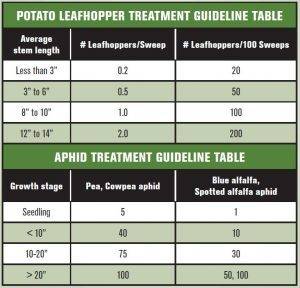Late-Summer Insect Management Helps Alfalfa Plants Prepare for Winter
 We work so hard to help crops to reach their yield potential. There is so much promise when a crop emerges from the ground… and then the uninvited bugs show up to the party robbing yield and causing disease. The chart provided reviews the life cycle of these yield-robbing insects.
We work so hard to help crops to reach their yield potential. There is so much promise when a crop emerges from the ground… and then the uninvited bugs show up to the party robbing yield and causing disease. The chart provided reviews the life cycle of these yield-robbing insects.
The 2020 alfalfa bug of the year so far is the weevil. It’s only about a quarter-inch long, but these little weevils can do big damage! If you don’t see the alfalfa weevils, you’ll notice their presence. Look for pinhole or lacing-type feeding damage on leaves.
Weevil numbers can resurge quickly in the fall, and we have third and fourth cuttings of alfalfa to protect. It’s important to protect the crop in late summer, so tissue is intact to ensure the alfalfa plants capture nutrients required to overwinter.
Consider your spraying options if you see plant damage or notice the presence of weevils and other pests. As temperature cool in the fall, it’s more challenging to control pest populations because insecticides must come into contact with the bug. A bug’s activity levels decline as temperatures decline. Bugs may move toward the hard to reach, lower portion of plant.
Fall Seeding
Seeding earlier is better because it helps ensure good crown development. If there is a delay in moisture, seeding earlier increases the window of getting rain to facilitate rapid emergence. Remember, it’s important to get a good crown developed to prevent winterkill.
Now is a great time to tentatively plan which acres will be seeded and line up your seed. Below are a few considerations for late summer and early fall seeding:
- Herbicide carryover. There have been many surprises in cover crop and fall alfalfa seeding. The seed will emerge. Once the radicle comes into contact with the carryover herbicide in soil, the plant dies. Here is a guide of some commonly applied spring herbicides and rotation restrictions: https://extension.sdstate.edu/sites/default/files/2019-08/P-00124.pdf
- Seed-to-soil contact ensures the seed quickly gets moisture. Quick emergence is critical in the fall.
- Time can be your friend or enemy. Alfalfa breeders suggest fall seeding is complete by August 15 if you are roughly north of Interstate 90 and by September 1 if you are south of I-90. The later you start, the more risk you encounter for establishing the crown. Alfalfa seed is an investment worth protecting.
- Latham’s AlfaShield™ seed treatment helps draw moisture to the seed. There’s a reason our ads read: Emerge Fast. Grow Strong. Yield MORE! Alfalfa seed must imbibe at least 125% of its weight in moisture to germinate, but it needs more available moisture to sustain growth. AlfaShield also contains key micronutrients and a growth promoter called Optimize Gold that accelerates early nodulation to speed up capturing nutrients. This process is critical to getting those desired nutrients and carbohydrates into the crown for winter survival.
Fall seeding is a great way to get a jump start on next spring’s work and to capture more yield. Feel free to contact me if you have any questions.